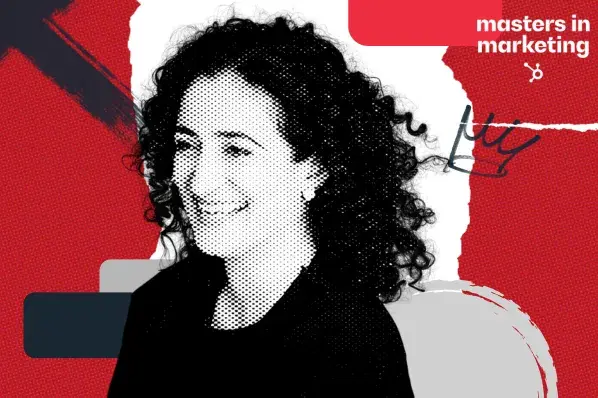The 2023 We❤️NYC campaign was intended to encourage New Yorkers, still pessimistic in a post-pandemic world, to show love for their city.

And boy, did it ever.
Last year, Maryam Banikarim royally pissed off the Olsen twins and the Jonas Brothers with her We❤️NYC campaign. But that same campaign earned twice the impressions of a Super Bowl ad … in 48 hours.
I caught up with Banikarim to get her top marketing lessons, and it was immediately clear that she’s the embodiment of “do what you love” — and it all stems from asking herself, “What if I did that?”
So we talked about purpose-driven work, how to use curiosity to power your marketing campaigns, and the best way to stay on top of new tech.
“What if I did that?”
1. Good campaigns have tension. That’s what gets people talking.
I can see Banikarim’s eyes sparkle through my computer monitor as she tells me how she ruffled the feathers of two sets of celebrity siblings. She’s relishing the memory of it.
Her agency worked on the city-wide ad campaign, which was funded by members of the Partnership for New York City to encourage civic action and community engagement. It capitalized on something New Yorkers care very, very deeply about: New York.
Once “We❤️NYC” began appearing on bus stop signs, at Barclays Center, and across Times Square, “everybody thought we were trying to get rid of the I❤️NYmark,” she says. They weren’t, but “communication isn’t what I say, it’s what you hear.”
So once somebody (incorrectly, angrily) posted that the new campaign was trying to oust Milton Glaser’s iconic I❤️NY, it became a reality of sorts. A reality that was picked up by talk shows, Mary-Kate and Ashley, and the Jonas Brothers — “it was just a whole thing,” Banikarim says with a laugh.
There’s no putting the toothpaste back in the tube: We❤️NYC was now a putative threat to New Yorkers’ identity and their iconography. Tension built up; tweets rolled in. “Milton Glaser would be so mad.” “Can we please let Milton Glaser rest in the peace he deserves?” “Milton Glaser got it right the first time.”
Banikarim is delighted by this. “We couldn’t have bought that media,“ she says.
Your next campaign probably won’t pique the ire of the Olsen twins (though a girl can dream). But know what your target audience feels ownership over, and where to tease out the tension in your marketing campaign.
2. DIY — with curiosity.
“I always seem to have a side hustle these days,” she tells me. (One gets the sense that Banikarim has always had to have a side hustle.)
It’s just that Banikarim’s side hustles would make most primary hustles envious. Last weekend, she celebrated the third year of The Longest Table, a community-building event born out of a need for human connection back when everyone was masking up and sharing tips on finding Lysol wipes.
She saw a neighbor put a folding table outside so they could eat dinner with a few friends. She introduced herself and thought, “What if I did that?”
One also gets the sense that Banikarim doesn’t do rhetorical questions. She started with a few posts on Next Door and an eight-person outdoor potluck on her street in Chelsea. On October 6, 2024, over a thousand people showed up for dinner.
Together they cobbled together a Squarespace website, and “we use HubSpot to email people.” (We did not bribe, pay, or threaten her to say that.—ed.) Banikarim doesn’t complain about DIY marketing tech; on the contrary, she refuses to be outpaced by evolving technology.

“Marketing has always been for people who are curious,” Banikarim says. And “in order to constantly be learning, it’s really helpful to be touching the tools yourself and not just directing from up high.”
3. Move sideways, move quickly. And take small bets.
Moving sideways means that sometimes you take a job that feels like a lateral move, or even a step backward. That’s not unusual now, but Banikarim jokes that she was a millennial before her time, because she’s had so many jobs for somebody in her 50s.
“But I was always looking for purpose in the job.” Like millennials, she’s “looking for impact.”
Your marketing career “doesn’t have to always be moving up. You can move sideways. You can move off, you can move in.”
Of course, millennials don’t need Banikarim to tell them that it’s okay to have a non-linear career. But are you moping about it or are you learning from it? (No judgment; glass houses and all that.)
“I think there‘s a lot of lip service given to this idea that if you fail, it’s ‘okay,’” she tells me. And then she says what so many of us feel in those moments: “but it’s not really okay.”

When I ask her what the biggest waste of money is across the marketing landscape, she says that it isn’t a tool. It’s that “we all have to be better at finding things that we can test and learn from” — and we have to stop thinking that if those tests don’t work, then they’re a mistake or a waste of time.
Her advice: Move quickly. Take the small bets. See where you get signal — and then go big.



